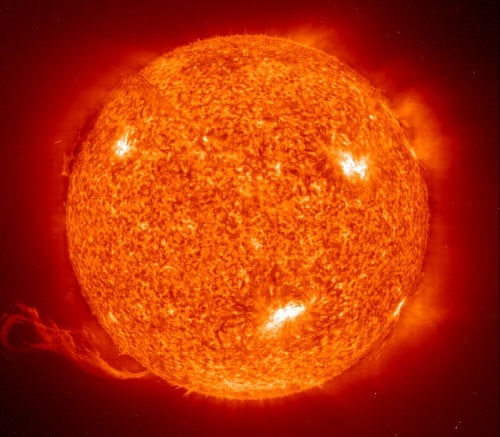Dire, perhaps, but this will occur far enough in the future that it’s difficult to muster any concern now. Fatalists, on the other hand, have plenty to worry about; the Sun may be middle-aged, but our planet is downright elderly — and in the grips of a fatal illness. Earth will be uninhabitable long before the Sun becomes a red giant.
The first hurdle — another ice age — is only a few thousand years away. Global warming may delay the next ice age a few hundred years, but global cooling is coming, and it will be devastating. In The Life and Death of Planet Earth, astrobiologists Peter Ward and Donald Brownlee predict that when the glaciers return, sea levels will drop by 400 feet and the areas where life can thrive will be reduced dramatically. Humanity might survive, but there will be a thousand-fold decrease in the volume of living plants and animals. University of Washington scientist William Calvin speculates that even a direct meteor hit capable of killing the majority of humans wouldn’t be as catastrophic in the long-term as massive global cooling.
The next ice age, however, won’t last forever. The Sun has been warming gradually; it currently is about 30 percent brighter than when it first formed. As the Sun’s temperature increases, Earth’s plant life will die, and the amount of carbon dioxide in our atmosphere will decrease. Just when this will happen has been a subject of considerable debate, but it’s likely to occur between 500 million and 700 million years from now.
Once the plants die, the rest of Earth’s life will follow. The amount of oxygen in the atmosphere will stand at 1 percent (it’s currently 21 percent), and the average temperature will be 160° F (70° C). At this point, about 1 billion years from now, the Sun will be 10 percent brighter than it is now, and our oceans will begin to evaporate.
It’s difficult to say how far technology will have advanced by the time all this happens. The terraforming and colonization of Mars is a popular solution, but this could take hundreds, or even thousands, of years. In addition, even if humanity undertakes such a monumental task, the same processes that will fry Earth will fry Mars. Mars just isn’t far enough away to escape a bleak future.
The water worlds of Jupiter (Europa, Callisto, and Ganymede) often are posited as places that might be able to support life, but this idea is just as often dismissed. The environments are not at all conducive to human life; Ward and Brownlee write that “it is more likely that humans will transform into some strange kind of superbeings that could thrive in hostile environments than it is that these distant moons could be made at all Earth-like.” The difficulties of interstellar travel are even more pronounced because of the great distances and large time scales involved.
If, however, humanity is not able to move to a different planet, perhaps we could just move the one we’re on. In a 2001 paper in the journal Astrophysics and Space Science, Don Korycansky, Gregory Laughlin, and Fred Adams suggested the use of gravity assists to nudge Earth’s orbit outward by just the right amount to escape the effects of the ever-brightening Sun. When a body such as a comet flies past a planet, the gravitational interaction either adds to or subtracts from the planet’s orbital energy. The team proposed a 100-kilometer-wide spacecraft weighing 117 tons act like a comet and fly by Earth every 6,000 years or so. It then would loop around Pluto, passing Jupiter and Saturn along the way. Although the comet would lose energy as it passed Earth, it would gain energy flying by Jupiter. Its orbit would move inward, and Earth would move outward, to where Mars orbits today. This bit of astronomical engineering could extend Earth’s life span by about 6 billion years.
The risks of this approach are great. The proposal is to have a large comet zooming very close to Earth at great speed. If something went wrong and the comet crashed into the planet, it would do so with enough energy to destroy all life. In addition, the encounters would push the Moon out of Earth’s orbit and into an orbit around the Sun that would intersect with our planet’s. Left on its own, the Moon could crash into Earth, which would be more devastating than the cometary collision. There is also the small matter of moving Mars out of the way to make room for Earth.
This, of course, is speculation. No one knows how far technology will advance, or whether some asteroid will crash into the planet and destroy everything. Only time — hopefully a very long time — will tell.










